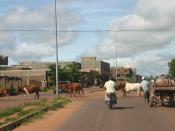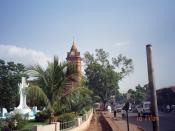The novel was published in 1960, just before Senegal became independent. It is based on a famous railroad strike which occurred in 1947-48. The novel focuses on the late stages of French colonialism. Sembene writes a dramatic and compelling story about the strike. He also uses it to make economic, political, and cultural points, as well, in support of Senegal's struggle against the French and labor's struggle with management.
The novel will seem familiar in form and style. That is, it's a realist-didactic, strike novel that utilizes Western techniques. It is a political novel. The narrative is direct and sequential. The novel may seem long, but it's a relatively easy and "good" read. It has a "cinematic" quality in its emphasis on visual imagery, setting, and action. The opening descriptions of place (Bamako) and person (Niakoro) are typical. So is the set-up for "Thiès: The City" on page 13. Note, as well, how the narrative seems to "pan" the market place on pages 15 and 16.
The large number of characters and the way the setting moves from place to place may pose some difficulty, but they're fairly simple to sort out. The map helps with places. Making lists of characters associated with each town helps, as well.
The action takes place in several locations (an interesting filmic term)--primarily in Bamako, Thiès, and Dakar. The map at the beginning shows the locations and suggests that the story is about a whole country and all of its people. There is a large cast of characters associated with each place. Some are featured players--Fa Keita, Tiemoko, Maimouna, Ramatoulaye, Penda, Deune, N'Deye, Dejean, and Bakayoko. Others part of the populace. You could say that the fundamental conflict is captured in two people, Dejean (the French manager and colonialist) and Bakayoko (the soul and...


